| Skip Navigation Links | |
| Exit Print View | |

|
Oracle Java CAPS Adapter for Batch Tutorial Java CAPS Documentation |
| Skip Navigation Links | |
| Exit Print View | |

|
Oracle Java CAPS Adapter for Batch Tutorial Java CAPS Documentation |
Oracle Java CAPS Adapter for Batch Tutorial
Importing Non-JBI Based Sample Projects
To Import a Non-JBI Based Sample Project
About the Oracle Java CAPS Business Process Manager Sample Project
Considerations for BPM Projects
Creating the bpBatch_Inbound_LocalFileIn_FTPOut Project
Creating the bpBatch_Inbound_LocalFileIn_FTPOut Business Process
To Create the Business Process
Adding Business Rules to the Design Elements
To Generate the Connectivity Map
Configuring the Adapters' Properties
To Configure the BatchInbound Adapter Properties
To Configure the BatchLocalFile Adapter Properties
Configuring the BatchFTP Adapter Properties
Creating the Deployment Profile
To Create the Deployment Profile
Building and Deploying the Project
prjBatch_Inbound_FTPIn_LocalFileOut
Considerations for JCD Projects
The Adapter for Batch JCD Sample Projects
The prjBatch_Inbound_FTPIn_LocalFileOut Sample Project
Creating the Java Collaboration Definitions
Creating the jcdBatch_Inbound_FTPIn_LocalFileOut Collaboration
To Create the jcdBatch_Inbound_FTPIn_LocalFileOut Collaboration
Using the Java Collaboration Editor
To Create the jcdBatch_Inbound_FTPIn_LocalFileOut Collaboration Business Rules
To Generate the Connectivity Map
Configuring the Adapters Properties
To Configure the BatchInbound Adapter Properties
Configuring the BatchFTP Adapter Properties
The prjBatch_Streaming Sample Project
Creating a Java Collaboration Definition
To Create the jcdBatch_Streaming Collaboration
Using the Java Collaboration Editor
To Create the jcdBatch_Streaming Collaboration Business Rules
To Generate the Connectivity Map
Configuring the Adapter Properties
To Configure the BatchInbound Adapter Properties
Configuring the BatchFTP Adapter Properties
Configuring the File Adapter Properties
Building and Deploying the Project
The prjBatch_Record Sample Project
Creating a Java Collaboration Definition
To Create the jcdBatch_Record Collaboration
Using the Java Collaboration Editor
To Create the jcdBatch_Record Collaboration Business Rules
To Generate the Connectivity Map
Configuring the Adapter Properties
To Configure File Adapter Connectivity Map Properties
To Modify the File Adapter Environment properties
To Configure the BatchRecord Adapter Properties
To Modify the BatchRecordParse Adapter Connectivity Map properties
To Modify the BatchRecord Adapter Environment properties
To Create the Deployment Profile
Building and Deploying the Project
The prjBatch_Secure Project Components
The prjBatch_Secure Project Collaboration Definitions
To Create the jcdBatchFTPOverSSL Java Collaboration
To Create the jcdBatchSCP Java Collaboration
To Create the jcdBatchSFTP Java Collaboration
jcdBatchFTPOverSSL Business Rules
jcdBatchFTPOverSSL Java Source File
Completing the prjBatch_Secure Project
Configuring the Adapter Properties
To Configure the File Adapter Connectivity Map properties
To Modify the File Adapter Environment properties
To Modify the Batch/FTP Adapter Connectivity Map Properties
To Modify the BatchFTPoverSSL Adapter Environment Properties
To Create the Sample Directories
To Create the Deployment Profile
This topic describes how to create the Batch_FTPIn_LFOut_Sample Project.
Next, you create the jcdBatch_Inbound_FTPIn_LocalFileOut Collaboration Definition. A Java Collaboration Definition contains Business Rules that define the processing and transport of data between the Enterprise Service Bus components. The Java Collaboration Definition Wizard is used to create the Java Collaboration Definitions. Once a Collaboration is created, the Collaboration Editor is used to create the Business Rules of the Collaboration.
The jcdBatch_Inbound_FTPIn_LocalFileOut Collaboration defines how data is transferred between the BatchInbound application, the BatchFTP application, and Outbound BatchLocalFile.
The Collaboration Definition Wizard (Java) appears.
The BatchFTP OTD is added to the Selected OTDs field.
The BatchLocalFile OTD is added to the Selected OTDs field.
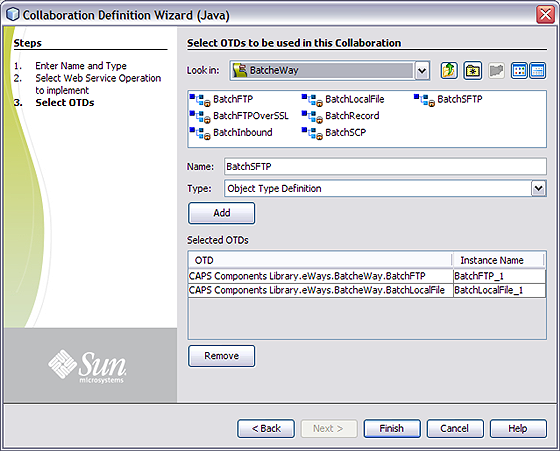
The new jcdBatch_Inbound_FTPIn_LocalFileOut Collaboration appears in the Project tree.
The prjBatch_Inbound_FTPIn_LocalFileOut Project uses the jcdBatch_Inbound_FTPIn_LocalFileOut Collaboration you created in the previous topic. To complete the Collaboration, use the Java Collaboration Editor to create the Business Rules.
Be careful to open all nodes specified in the directions to connect the correct items.
The Java Collaboration Editor opens to the jcdBatch_Inbound_FTPIn_LocalFileOut Collaboration.
The Enter a Comment dialog box appears. The comment is placed on the Business Rules tree under the last selected item.
Once the comment is created, you can move it by clicking the comment and dragging it up or down the Business Rules tree to a new location.
The BatchFTP_1.Client.get rule gets the file from the FTP Client.
The method selection window appears.
The get method box appears in the Business Rules Designer canvas.
The Copy BatchFTP_1.Client.Payload to BatchLocalFile_1.Client.Payload rule writes the contents of the retrieved file to the payload of the BatchLocalFile.
The setPaylod method box appears.
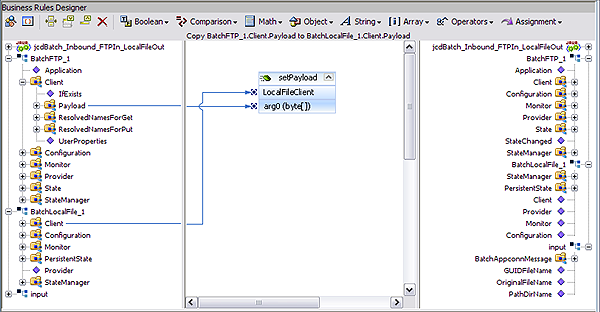
The Copy input.GUIDFileName to BatchLocalFile_1.Configuration.TargetFileName rule gives a GUID to the target file, BatchLocalFile Adapter.
The setTargetFileName method box appears.
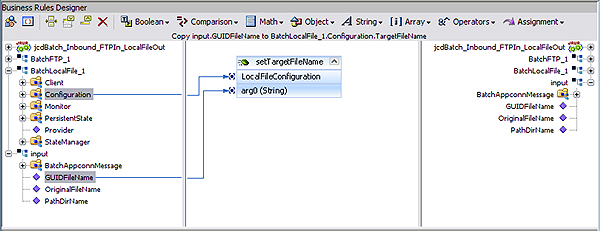
The BatchLocalFile_1.Client.put rule publishes the file to a local directory.
The method selection window appears.
The put method box appears in the Business Rules Designer canvas.
A Connectivity Map provides a canvas for assembling and configuring a Project’s components.
The new Connectivity Map appears and adds a node on the Project tree labeled CMap1.
Once your Java Collaboration Definition is completed you can use it to generate your Connectivity Map. Generating the Connectivity Map will automatically populate the canvas with the correct components and bind the components according to the information provided by the Java Collaboration Definition.
The cmBatch_Inbound_FTPIn_LocalFileOut_jcdBatch_Inbound_FTPIn_LocalFileOut1 service is added to the canvas.
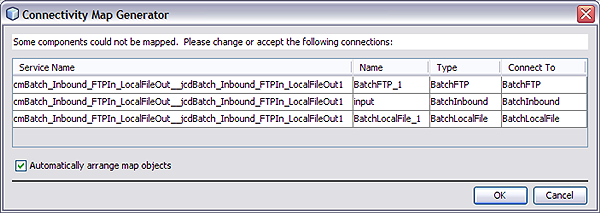
The External applications are added to the Connectivity Map and the Bindings are created. The red squares in the bindings represent the Batch Adapters. The red color indicates that the adapter properties have not been configured.
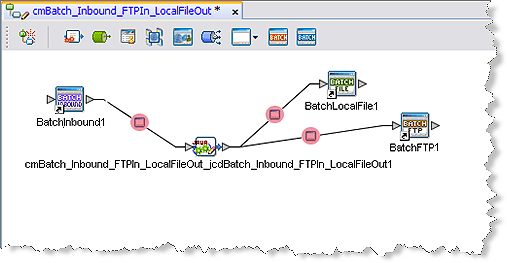
Environments include the External Systems, Logical Hosts, Application Servers, and Message Servers used by the Project and contain the configuration information for these components.
A new Environment is added to the Services tree.
The esBatchInbound box is added to the Environment Editor.
The esBatchFTP box is added to the Environment Editor.
The esBatchLocalFile box is added to the Environment Editor.
The LogicalHost1 icon is added to the Environment and LogicalHost1 is added to the tree.
A new Application Service is added to the tree under LogicalHost1 .

The prjBatch_Inbound_FTPIn_LocalFileOut Project contains three Adapters, each represented in the Connectivity Map as a node between an External Application and a Collaboration. The Adapters facilitate communication and movement of data between the external applications and the Enterprise Service Bus system.
The Adapter Properties Editor appears.
| ||||||||
The BatchInbound Adapter Environment properties can keep the default settings for this Project.
Perform the following steps to configure the Batch Adapters and create the deployment profile:
The Adapter Properties Editor appears.
| ||||||||
The Properties Editor opens to the BatchFTP Adapter Environment properties.
| ||||||||||||
The Adapter Properties Editor appears.
| ||||||||
A Deployment Profile is used to assign Collaborations and message destinations to the Application Server and message server. Deployment Profiles are created using the Deployment Editor.
Make sure that the selected Environment is envBatch_Inbound_FTPIn_LocalFileOut.
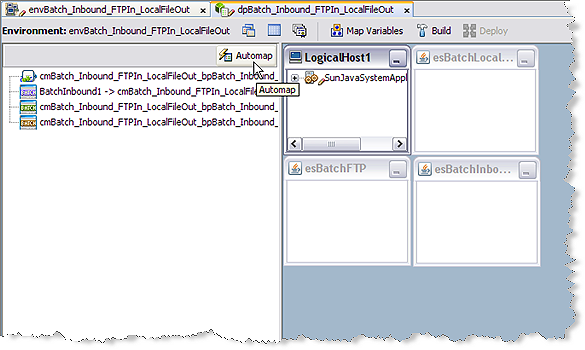
The Project’s components are automatically mapped to their respective system windows.
Note - If any of your Project components do not successfully map to an external system, open each of your Adapter’s configuration properties (Connectivity Map and Environment) and click OK to close and save the current configuration, then click Automap again.
The Build process compiles and validates the Project’s Java files and creates the Project EAR file.
If there are any validation errors, a Validation Errors pane will appear at the bottom of the Deployment Editor and displays information regarding the errors.
Before You Begin
Make sure the GlassFish server is started.
The Deploy prompt appears.
A message appears when the project is successfully deployed.
To run your deployed sample Project do the following
Note - For UNIX, be sure to upload the appropriate LogicalHost.